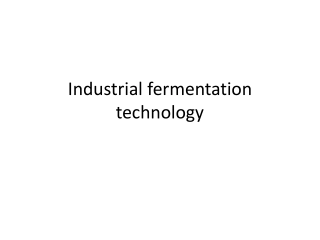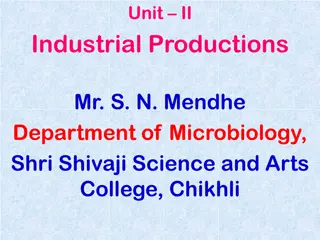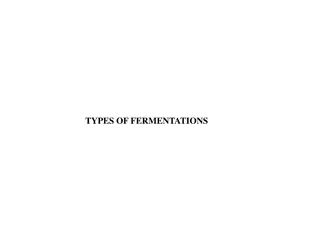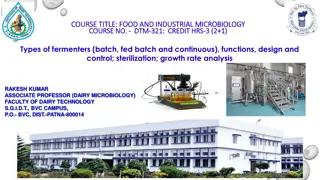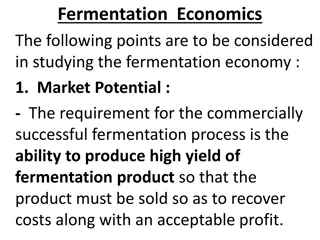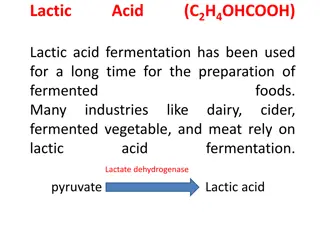Understanding Types and Benefits of Solid State Fermentation
Fermentation is a metabolic process involving enzymes transforming organic substrates. Solid state fermentation (SSF) is a method without free water, crucial for enzyme production using natural materials like grains and fruit pulps. This process is cost-effective, environmentally friendly, and easy to aerate, making it suitable for various industries.
Download Presentation

Please find below an Image/Link to download the presentation.
The content on the website is provided AS IS for your information and personal use only. It may not be sold, licensed, or shared on other websites without obtaining consent from the author. Download presentation by click this link. If you encounter any issues during the download, it is possible that the publisher has removed the file from their server.
E N D
Presentation Transcript
Fermentation Fermentation is a metabolic process that produces chemical changes in organic substrates through the action of enzymes. Fermentation can be carried out as: 1. Batch 2. Continuous 3. Fed-batch processes
Types of fermentation Fermentation can be carried out as: 1. Batch 2. Continuous 3. Fed-batch processes
Types of fermentation Fermentation is the chemical transformation of organic substances into simplex compounds by the action of enzymes, complex organic catalysts which are produced by microorganism such as yeast, molds or bacteria. In another words, fermentation is the technique of biological conversion of complex substrates into simple compounds by various microorganism. FERMENTATION, classified on the basis of substrate used 1. Solid state fermentation (SSF) 2. Submerged fermentation (SmF) of bioactive compounds such as antibiotics, pigments, antioxidants, antitumor agent, bio- surfactants, bioactive peptides etc. The metabolism exhibited by microorganism is different in SSF and SmF. Development of this fermentation techniques has leads to industrial level production
Solid state fermentation (SSF) Solid state fermentation (SSF) has been defined as the fermentation process occurring in the absence of free water. Solid state fermentation is a method used for the production of enzymes, which involves the cultivation of microorganisms on a solid substrate, such as grains, rice and wheat bran. SSF employs natural raw materials as carbon source such as cassava, barley, wheat bran, sugarcane bagasse, various oil cakes like palm kernel cake, soybean cake, ground nut oil cake, fruit pulps (e.g. apple pomace), saw dust, seeds (e.g. tamarind, jack fruit), coffee husk and coffee pulp, tea waste etc. Important Features Solid state fermentation has been defined as the fermentation process occurring in the absence or near absence of free water utilizing the solid substrate. It is a biomolecule manufacturing process used in the food, pharmaceutical, cosmetic, fuel and textile industries. These biomolecules are mostly metabolites generated by microorganisms grown on a solid support selected for this purpose. This technology for the culture of microorganisms is an alternative to liquid or submerged fermentation, used predominantly for industrial purposes
Why solid state fermentation ? Simple and cost effective Less effluent release, reduce pollution Aeration is easy Resembles the natural habitat of some fungi and bacteria SSF utilizes solid substrate, thus nutrient rich waste materials can be easily recycled as substrate Substrate are used very slowly and steadily so the same substrate can be used for longer fermentation period SSF is best suited for fermentation techniques involving fungi and microorganism that require less moisture content
Factors Involved in SSF Process Selection of Micro-organisms Substrate Process Optimization Product Isolation & Purification Selection of Micro-organism -- This is one of the key factor for improved yields of the product. Bacteria, Yeast and Filamentous Fungi can be used. Filamentous Fungi has shown better results growing in the solid substrate fermentation. Substrate -- Substrate also plays important role in determining the growth of micro- organisms, there by increasing the product yield. Substrate is chosen such a way that it should provide physical support as well as nutrients to the growing culture. Substrate is of two types: One is Specific substrate, which requires suitable value-addition and / or disposal. The second is for producing a specific product from a suitable substrate.
Process Optimization It is the optimization of physico-chemical and Biochemical Parameters which includes size, initial moisture, pH and pre-treatment of the substrate, Relative humidity, temperature of incubation, agitation and aeration and age and size of the inoculum. Nutrient Supplementation such as N, P and trace elements and supplementation of additional carbon source and inducers. Extraction of product and its purification. Applications: Solid State fermentation is being employed in various fields ranging from pharmacology to bioremediation, covering various aspects of biodiversity conservation. These are the applications of Solid State fermentation -- Production of Industrial Enzymes as almost all the known microbial enzymes can be produced under SSF systems. Enzymes of industrial importance, like proteases, cellulases, ligninases, xylanases, pectinases, amylases, phenolic acid esterases, microbial rennets, oligosaccharide oxidases etc. using SSF systems. Production of Bio pesticides -- The infamous Bacillus thurengenesis (Bt) s protein can be produced in large scale in order to address the issues of pest attacks-yield damage.
Submerged fermentation Submerged fermentation / liquid fermentation It is a techniques of cultivation of microorganism in liquid broth which breaks down the nutrient to release the desired bio-active compound into solution. In this method, selected microorganism are grown in closed vessels containing a broth rich in nutrients and high concentration of oxygen. In SmF substrate are utilized quite rapidly hence need to be constantly replaced or supplemented with nutrients. Bacteria that requires high moisture content or high water activity are best suited for submerged fermentation. Applications of Submerged Fermentation (SmF) / Liquid Fermentation (LF) -- SmF utilizes free flowing liquid substrates, such as molasses and broths. The bioactive compounds are secreted into the fermentation broth. The substrates are utilized quite rapidly that s why substrate needs to be constantly replaced / supplemented with nutrients. This fermentation technique is best suited for microorganisms such as bacteria that require high moisture. An additional advantage of this technique is that purification of products is easier. SmF is primarily used in the extraction of secondary metabolites that need to be used in liquid form.
More that 75% of the industrial enzymes are produced using SmF, one of the major reasons is that SmF supports the utilization of genetically modified organisms to a greater extent than SSF. In SmF, the accumulation of variety of intermediate metabolites results in lowered enzyme production efficiency Based on research, certain bioactive compounds have produced in higher quantities in SSF, whereas other compounds have been extracted using SmF activity and found to be



